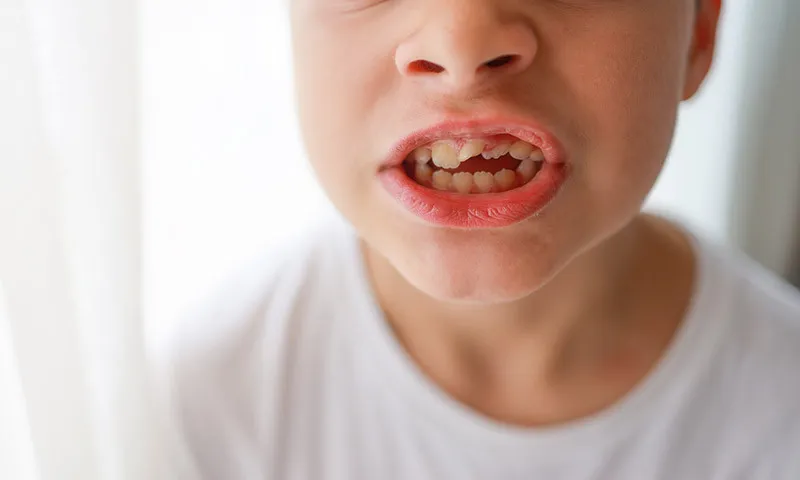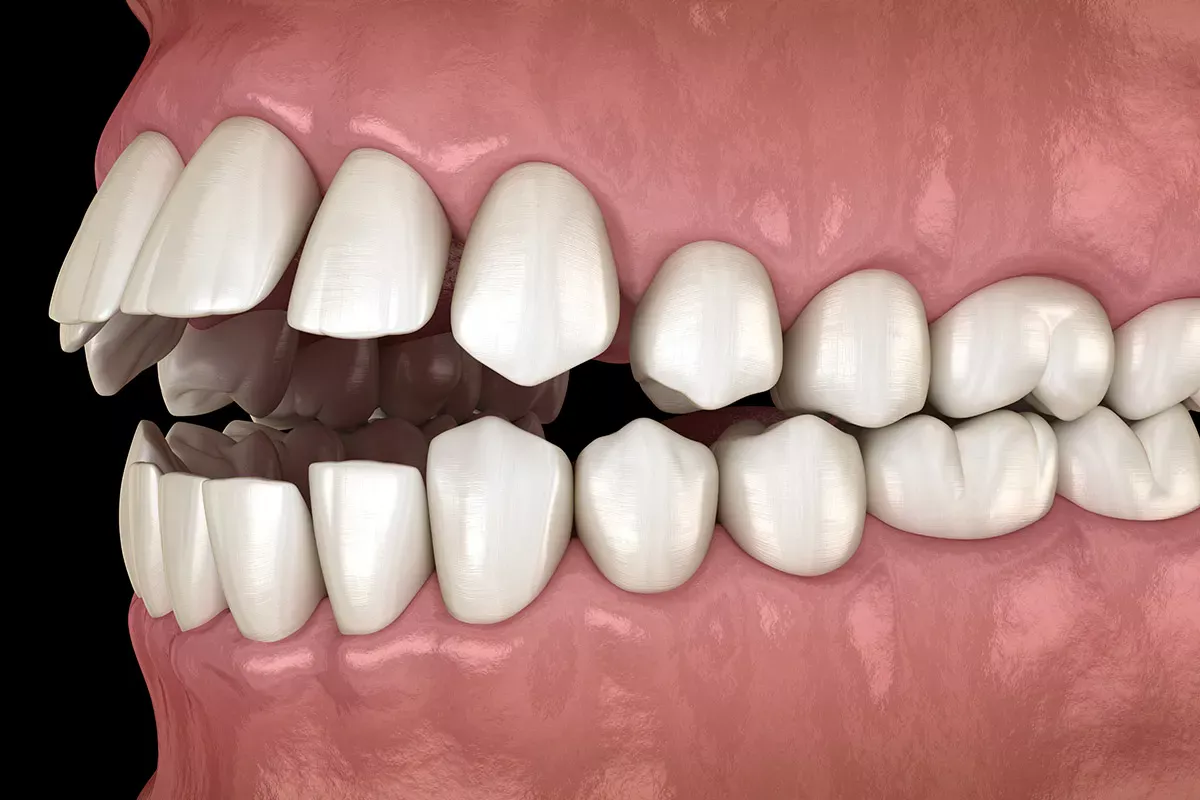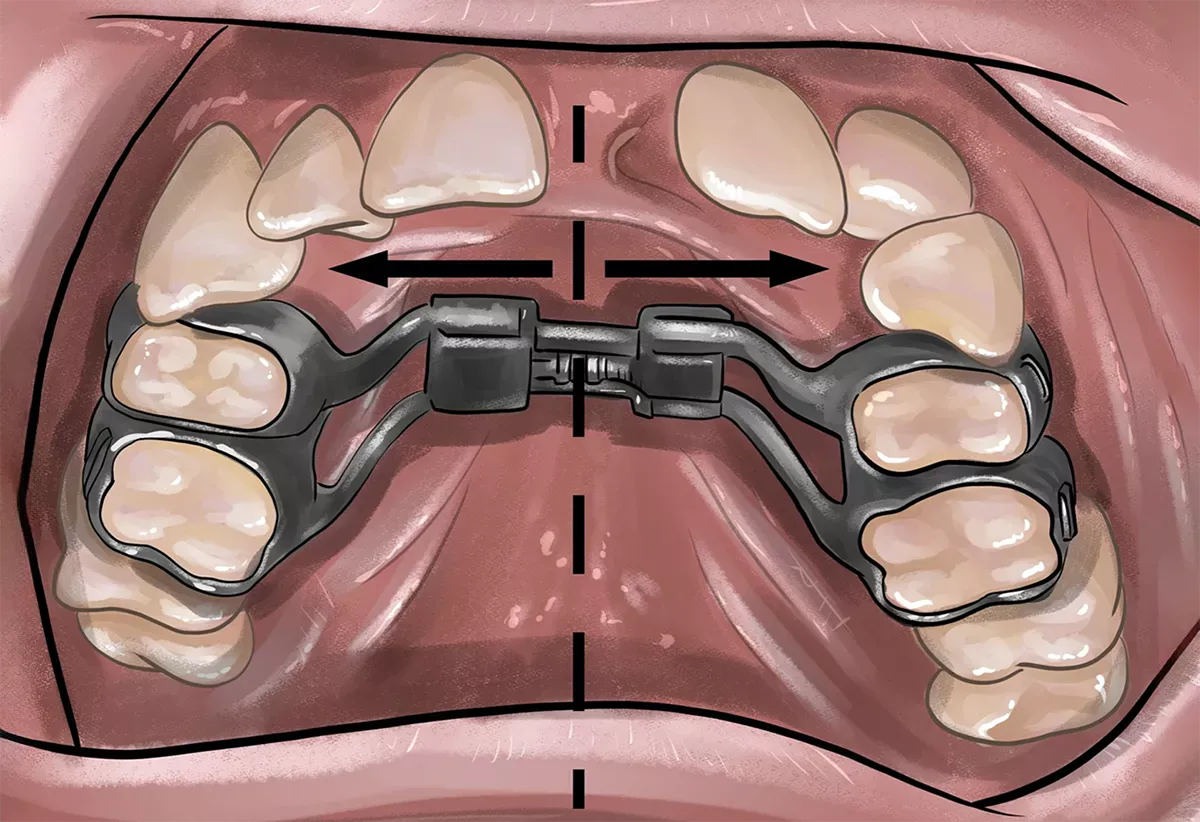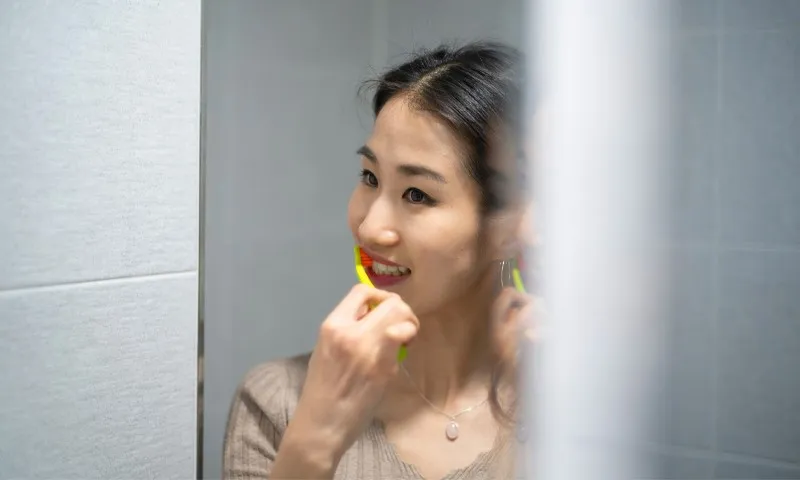The most important facts in brief
- The open bite is often already evident on the milk teeth in infancy. It is usually a frontal gap that occurs between the upper and lower jaw when the teeth bite together. The most common reasons for this are thumb-sucking or using the wrong dummy. This is referred to as a dental open or open-sucking bite.
- However, there are also other reasons why an open bite develops; for example, genetic factors can play a role.
- An untreated open bite can - depending on the severity - cause discomfort. These include, for example, chewing and biting difficulties, speech problems or even problems with breathing properly.
- An open bite can usually be corrected most easily during childhood and adolescence because the jaw is still growing.
- There are numerous treatment options available for correction. The orthodontist decides which is the right one.
What is the open bite?
The term "open bite" is used to describe a jaw misalignment in which some teeth in the upper and lower jaw do not meet when the person bites down. Such an opening can occur in the front teeth, but also on the sides. An open bite is one of the most common jaw misalignments. In a healthy set of teeth, the upper and lower rows of teeth would completely close the oral cavity.
Good to know:
Around five per cent of the world's population is affected by an open bite.
Depending on the cause of the malocclusion, it is referred to as either a dental open bite or a skeletal open bite. We explain what this distinction means here:
Dental open bite
The so-called dental open bite is often caused by habits such as thumb sucking or using the wrong dummy; this is why it is also referred to as habitual open bite. Both behaviours can lead to the jaw becoming deformed and an open bite - usually in the anterior region. This can also result in a misalignment of the milk teeth .
Soothers for babies: The big guide
The deformation of the jaw can lead to misalignment of the tongue and the resulting speech problems and errors as well as swallowing and biting difficulties. If the bad habits are stopped at an early stage, there is a good chance that they will heal themselves and no treatment will be necessary.
Good to know:
To prevent your baby's jaw and teeth from being damaged by an incorrect soother, we recommend the Curaprox size 0 baby soother. It not only has a calming effect, but also actively prevents misaligned teeth, promotes nasal breathing and helps with the natural development of jaw growth. Thanks to the flat, soft teat, the tongue has enough room in the mouth and adopts its natural position. In addition, the baby's lips are almost completely closed when sucking.
Skeletal open bite
The term skeletal open bite is generally used when the cause of the malocclusion lies at the bony base, i.e. in the jaws. This type of open bite is often congenital and/or genetic and occurs less frequently than a dental open bite. In a skeletal open bite, it is not always just the front teeth that are affected. The open area between the upper and lower jaw can also appear on the sides.
The gap is caused by the lower jaw growing largely downwards during the growth phase. This often results in a long-looking face. This type of malocclusion is usually more difficult to correct than a dental open bite. Surgery may be necessary.
Important to know: Even if "only" bad habits are the cause of an open bite, a skeletal change can develop as a result. This can happen, for example, if the habits are not broken in time and are maintained in the long term. The prognosis for successful treatment is then often less favourable - this also applies if the open bite is not only present in the primary dentition but has already progressed to the permanent dentition.
Different types of open bite
It is not only the causes of an open bite that can vary. As already briefly mentioned, the gap that occurs when the teeth bite together can occur in different places in the jaw. A distinction is made here between a frontal open bite and a lateral open bite.
Read here what the differences are.
Frontal open bite
This type of open bite is, so to speak, the classic in children. As already mentioned, it is usually caused by thumb-sucking or sucking on the wrong dummy. However, there are other reasons why a gap can form between the upper and lower row of teeth when biting together in the anterior region:
- Tongue dysfunction: If the tongue lies between the rows of teeth when speaking or swallowing, it prevents the teeth from growing out vertically. As a result, the front teeth cannot bite together properly.
- Obstructed nasal breathing: If the mouth has to be opened permanently to breathe, a narrow upper jaw with vertical growth can develop.
- Dental trauma during adolescence: Accidents and injuries can lead to root curvature or root growth arrest - which can result in a frontal open bite.
- Supernumerary teeth: They can prevent teeth from erupting and thus contribute to malocclusion.
- Rickets: This bone disease can result in a so-called rachitic open bite. However, this special form is no longer often seen today, as children are given prophylaxis with vitamin D supplements, which can prevent the development of rickets. The rachitic open bite is often more pronounced than the dental open bite, it is difficult to treat and there is a tendency for it to recur.
Good to know:
The frontal open bite favours a lateral crossbite. This is another jaw misalignment in which the upper teeth do not overlap the lower teeth as they normally should, but vice versa. This means that either the lateral teeth of the upper jaw are too far inwards or the lateral teeth in the lower jaw are too far outwards.
Laterally open bite
In a laterally open bite, as the name suggests, there is a gap between the upper and lower dental arch on both or only one side. Lateral open bite is usually classified as skeletal open bite. This means that there are often genetic causes. One reason for the formation of a lateral gap could be, for example, a lack of space for the permanent teeth. This favours an open bite.
With a laterally open bite, chewing is usually only possible to a limited extent because the chewing surfaces do not meet. This can lead to digestive disorders.
Open bite: These complaints can arise
The symptoms depend on many factors - for example, how pronounced the malocclusion is and what type of open bite is present. In general, the following possible symptoms can be named.
Problems with food intake
If the jaws do not develop optimally and the chewing surfaces of the teeth do not meet in one or more places, those affected may find it difficult to chew or bite down.
Temporomandibular joint problems
With a laterally open bite, not all teeth are involved in chewing. The temporomandibular joint must therefore absorb many chewing forces. These loads can lead to problems with the temporomandibular joint.
Language problems
As the open bite usually develops in childhood, speech development may be impaired. One reason for this may be that the tongue moves forwards into the gap between the upper and lower incisors in a frontal open bite, causing children to lisp.
Growth inhibition of the upper jaw
With a frontal open bite, there is a risk that the upper jaw will not develop correctly. As described in the previous section, this can also be due to the tongue, which does not stimulate the upper jaw due to the malocclusion, but instead moves forwards into the open gap between the upper and lower front teeth. However, this stimulation of the upper jaw is an important growth stimulus, which therefore fails to materialise.
Tendency to mouth breathing
With an open bite, there is a high risk of breathing through the mouth instead of the nose. This can result in further problems: The inhaled air is not humidified, warmed or cleaned of pathogens. In addition, the oxygen saturation of the air we breathe is ten per cent higher when breathing through the nose than when breathing through the mouth. Mouth breathing can therefore lead to sleep or concentration problems. Even poor posture, speech problems, hyperactivity and heart problems can be linked to an open bite.
Problems with your own visual appearance
In addition to physical discomfort, an open bite can also be a psychological burden. As the appearance differs from the norm, those affected may struggle with feelings of shame or complexes.
What risk groups are there?
Studies show that tooth and jaw misalignments are already widespread in the milk teeth of infants - including an open bite. The ominous foundation for the formation of an open bite can even be laid in babies if they suck their thumb intensively or suck on the wrong teat.
If a toddler already suffers from an open bite, there is at least a good prognosis: the chance of self-regulation is high at this age. This means that the malocclusion can very often be treated without surgery . Studies have shown that four to six-year-olds exhibit significant self-regulation. In other words, there was a regression without any treatment at all. The prerequisite is, of course, that the cause has been eliminated - in most cases, thumb sucking or sucking on the wrong dummy.
Good to know:
If there are already negative changes in the jaw due to incorrect soothers or thumb sucking, the Curaprox corrective soother in size 1 can be used to actively counteract this at around 12 months of age and size 2 from the age of two and a half. These soothers can correct existing malocclusions such as an open bite. The additional side wings direct the sucking pressure to the right and left and not upwards to the palate. The pressure is distributed evenly over the upper row of teeth, allowing the upper jaw to grow in width instead of upwards.
If regression does not occur on its own, if the malocclusion is not treated appropriately and if the cause for the formation of the malocclusion has not been eliminated, the open bite can persist into adulthood. We have already described the complaints that can accompany this above.
To prevent these symptoms, it is always advisable to have an open bite in childhood examined by a dentist or orthodontist. They will then decide whether treatment is necessary. In general, it can be said that the treatment of a dental open bite in children and adolescents is usually easier and more effective, as the jaw is still growing.
Good to know:
Even if the treatment of open bites in children and adolescents is often effective and time-efficient, the malocclusion can form again if the cause has not been eliminated. For example, if a toddler sucks their thumb excessively again after treatment or sucks on the wrong dummy, the open bite could sooner or later become a problem again.
Adults usually have to reckon with a longer treatment period. However, it is not possible to make a generalised statement about the duration of treatment and whether treatment without surgery is promising. This depends on many factors - including the severity of the deformity.
Treatment of the open bite: an overview of the options
How and whether an open bite is treated depends on many different factors. For example, the age of the patient or the severity of the malocclusion play a role. Only a dentist or orthodontist can advise you on your individual options. This also applies to the question of when can and should be treated. Here you will find an initial general overview of the therapies that could be considered in theory.
Treatment in childhood
If treatment of an open bite is already necessary in infancy or childhood, fixed or loose braces, oral vestibular plate therapy or palatal expansion (GNE) can be used, for example. If an open bite causes a speech defect, it may be advisable to start speech therapy treatment. You can discuss whether and which exercises are suitable for adults or children with an open bite and whether they are useful and helpful in your individual case directly at the speech therapy practice.
In general, it is unfortunately not possible to make a general statement about the treatment duration of the individual therapies and the question of whether they take place without surgery or only with such an intervention.
What is oral vestibule plate therapy?
At first glance, the oral vestibule plate gives the impression of a dummy. However, it is not a teat, but a C-shaped plate made of plastic that can be inserted into the mouth. As with a dummy, there is usually a handle on the outside.
The oral vestibular plate sits loosely in the vestibule between the front teeth and the lip. It is held in place by the lip muscles. If children wear the oral vestibule plate regularly as recommended by the doctor, it can help to train away unhealthy behavioural patterns such as thumb sucking or lip biting. It can also help to switch incorrect mouth breathing to nasal breathing. If there is an incorrect swallowing pattern, the oral vestibule plate can also help: In these cases, a tongue bar or tongue bead can also be added to train the tongue muscle.
Treatment in adulthood
Because jaw growth is complete in adults, the treatment of an open bite is often more difficult. Braces or a splint can be used, for example. Such aligners are also called aligners. Invisalign aligners are particularly popular with adults, as they are transparent and therefore hardly noticeable in everyday life.
For many patients, the question of how long braces should be worn is very pressing. However, how long you have to wear braces is a question that only your orthodontist can answer.
An open bite in adulthood cannot always be treated with braces or splints. If it is a skeletal open bite, for example, surgery may also be necessary.
In general, the following therapy options are possible:
- Orthodontic compensation treatment (orthodontic corrections with the help of braces or appliances)
- Palatal expansion
- Orthognathic therapy (surgical correction of misalignments of the jaw)
It is not possible to say which treatment is necessary and correct in each individual case. For this reason, we also advise caution when viewing before and after surgery images, which are widely available on the internet. These images can quickly give a false impression and promise things that may not be realisable in your specific case. Instead of being blinded by such before and after surgery images, you should seek detailed advice from experts.
What operating theatre costs can arise?
Unfortunately, there is no universal answer to this question. The cost of correcting teeth varies from country to country and of course also depends on the severity of the open bite and whether adults or children are affected. Before you agree to an operation, for example, you should find out from your health insurance provider what costs you will incur and how much you can expect to pay. In general, however, it can be said that you will usually have to pay for purely aesthetic procedures yourself.
Sources
Askeridis, Nikolaus: Study on the therapeutic success and stability of orthodontic treatment in patients with frontal open bite with overbite, status: 2006
Brunner, Dr.med.dent. Miranda: Information sheet GNE (palatal expansion) & plastic cap splint.
German Society for Orthodontics, S3 guideline: Ideal treatment times for orthodontic anomalies, status: 2021.
DocCheck Flexikon: Oral vestibule plate, as of: 2019.
Hacker, Tim: The open bite, status: 2007.
Havranek, Dr med. dent. Ladislav, specialist dentist for orthodontics (CH): Misaligned teeth and jaws.
Institute of German Dentists: Sixth German Oral Health Study, as of December 2021.
Kassenärztliche Vereinigung Land Brandenburg: Fachinformation der Kassenärztlichen Vereinigung Land Brandenburg, as of January 2015.
Köklü, Prof. Dr med. dent. Saduman O.: Typical malocclusions.
Medeco GmbH: orthodontics.
Mooci Gmbh, Quality Tested Information & Doctors, Open Bite (and all subpages), as of May 2023.
Mooci Gmbh, Quality Tested Information & Doctors, Crossbite (and all subpages), as of May 2023.
Sander, Franz Günter et al, Zahn-Mund-Kiefer-Heilkunde: Kieferorthopädie: Der frontal offene Biss, Edition: 2011.
Sander, Franz Günter et al, Oral and Maxillofacial Surgery: Orthodontics: Palatal Expansion, Historical Development, Edition: 2011.
Stelzenmüller, Wolfgang et al. in: Therapie von Kiefergelenkschmerzen: Vertikale Dysgnathien, Status: 2010.
University Medical Centre Freiburg: If necessary: palatal expansion at the beginning.
University Medical Centre Göttingen: Dysgnathia and surgery of jaw malpositions.
Ulm University Hospital: Early orthodontic treatment.
Wagner, Yvonne, Heinrich-Weltzien, Roswitha: ZWR, Das Deutsche Zahnärzteblatt: Auswirkungen eines Schnullers mit besonders dünnem Saugerhals auf die Okklusion im Milchgebiss - Ergebnisse einer randomisierten klinischen Studie, Status: 2020.
Wichelhaus, Andrea: Colour atlases of dentistry: Orthodontics - Therapy Volume 1: Orthodontic problems of the open bite, Edition: 2012.
Wichelhaus, Andrea: Colour atlases of dentistry: Orthodontics - Therapy Volume 1: Treatment of open bite in adults, Edition: 2012.
Wichelhaus, Andrea: Colour atlases of dentistry: Orthodontics - Therapy Volume 1: Treatment of open bite in the primary dentition, Edition: 2017
Wittig, Dr Hagen at www.kieferorthopaede089.de: Open bite: causes, effects and treatment in children and adults.
All websites last accessed on 26/05/2023
 Swiss premium oral care
Swiss premium oral care










